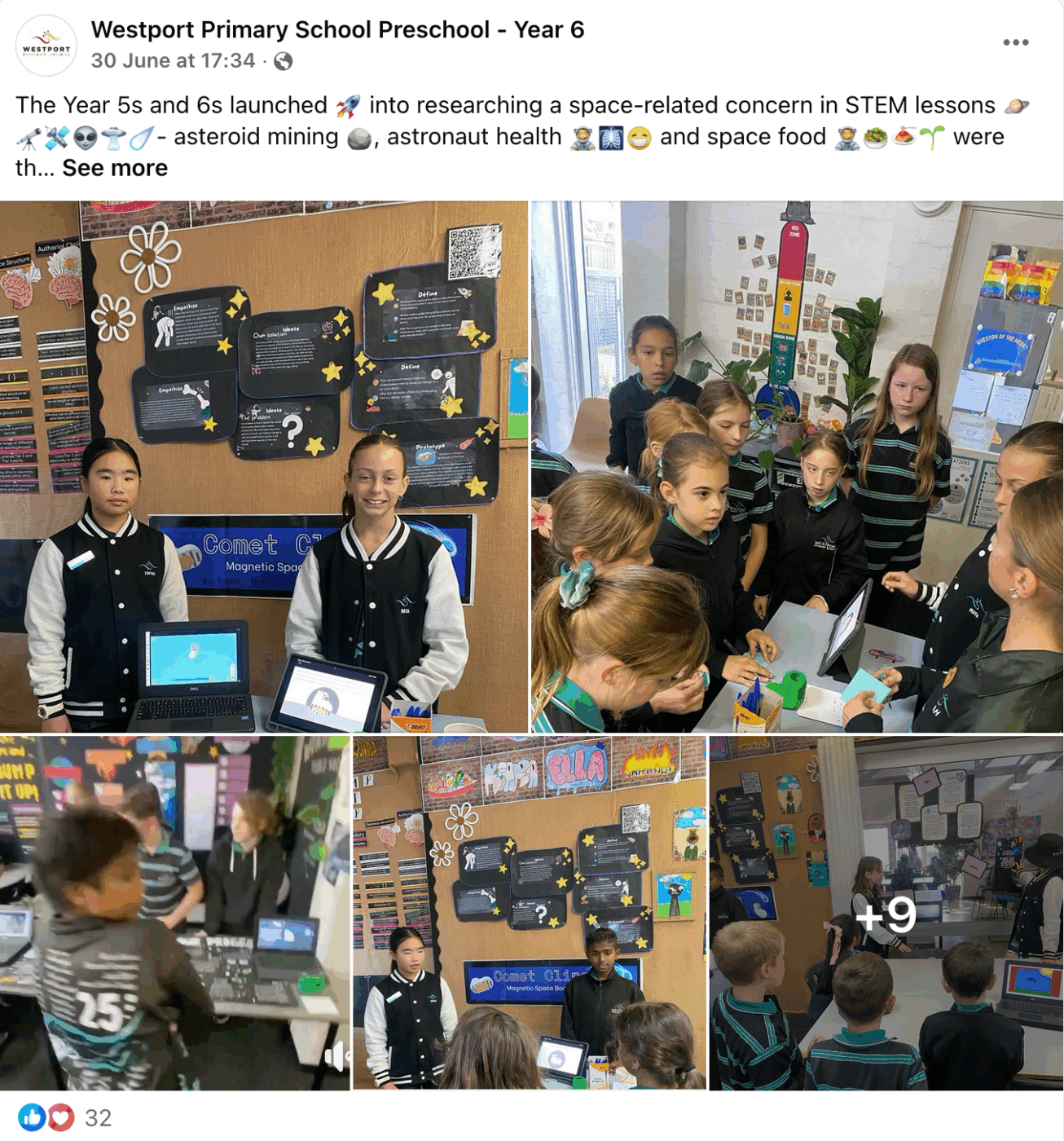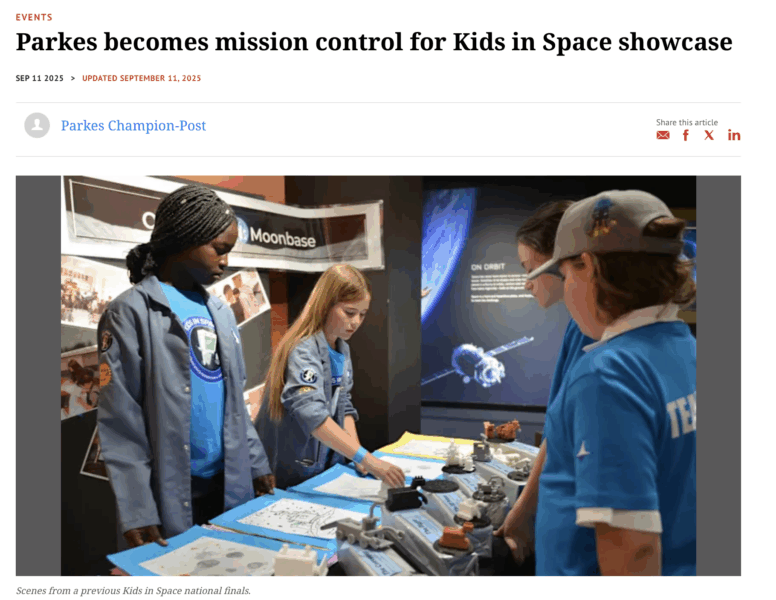The Andy Thomas Space Foundation, along with project supporter The Australian Space Agency, and delivery partner Makers Empire, are proud to present the following coverage of the third year of this exciting education program.
The Kids in Space Program engages primary school students in STEM learning and promotes awareness of careers in the space industry through real-world projects. This initiative offers an exciting opportunity to integrate space-themed STEM education into classrooms and inspire the next generation of innovators.
In 2024, the project engaged around 16,000 primary and middle school students, hundreds of teachers, and over 115 independent and Catholic schools across metropolitan, regional, and remote areas. Notably, 49% of participating schools were located in regional, rural, and remote communities, while 44% had an Index of Community Socio-Educational Advantage (ICSEA) value below 1000, highlighting the program’s strong reach into disadvantaged and geographically diverse communities.
Culminating in project showcases, students presented their responses to the design thinking challenge:
Design something that might help astronauts to work and live in space or use space technologies to design something that will help solve a problem on Earth.
The Kids in Space state/territory finals and showcase events are designed for schools to come together to share their learning, and to listen to guest speakers from the space industry. Schools were eligible for prizes awarded by both guests judges and their fellow students. Teams selected by the judges won a trip to Adelaide to compete in the national Kids in Space showcase at the Australian Space Discovery Centre in November.
11 Northern Territory schools participated in the Kids in Space Showcase for the territory finals at Woodroffe Primary School on June 13th.
Judges for this showcase included:
The NT State Winner was Sattler Christian College. In order to combat pollution, the students from Sattler Christian College designed three robots with different abilities to clean up pollution and rubbish.
Skybot flies and identifies areas to clean, then communicates to Mud Bot and Robbish who collect rubbish and sort for recycling. Their concept incorporates current space technologies including rocketry, GPS, satellite communication and radio.
Leanyer School was awarded the student-voted peer prize, with their design solution: a set of space-debris collecting rockets called Cassopeuis (Queens of the Sky)
Congratulations to both schools, and thanks to Woodroffe Primary School, our judges and ABC Radio Darwin for attending the event and interviewing students.
The Queensland schools participating in Kids in Space came together on June 17th for the state finals and showcase at Cooloola Christian College in Gympie.
The participating schools included:
The judges for the showcase included:
The Queensland state winner was Palmwoods State School with their project: a junk collector to recycle space junk, and increase space sustainability. Their design solution captures debris in a net and brings it back to Earth for sorting and recycling.
The peer prize winner was St James Lutheran College, with their Parkland reserve with metal detectors, designed to protect the environment from different threats.
Thanks to Cooloola Christian College, our esteemed judges and Perrie Moller from WINNEWS.
The 11 Victorian schools selected for 2025 Kids in Space Program came together on June 20th at the Wangaratta Performing Arts Centre for the Victorian showcase.
Showcase judges included
Congratulations to the students from Mount Beauty Primary School (Team 2), who were judged the overall winner! Students designed a pollution-cleaning rover for the ocean. Directed by space satellites, their creation uses GPS to locate debris and pollution in the ocean, and then deposits it into boats that take the rubbish to a designated Ocean Clean-up Port. From here the rubbish is transported to an incinerator where the waste is converted into fuel.
The peer prize as voted on by the students was won by Tungamah Primary School. They designed and 3d printed a range of fidget toys to help keep astronauts calm in space. The toys are attached to lanyards to ensure they are manageable in microgravity environments. They are designed with interactive features, including a squeezable material and heat reactive materials that change colour when held.
On June 23rd, Kids in Space ACT participants convened at Mungga-Iri Jingee Academy Of Future Skills in Canberra for the ACT finals and showcase.
Judges for this showcase were
Congratulations to the students from Wanniassa Hills Primary School (Team 1) who were judged ACT winner. Their design, the Debrix Machine, is a solar-powered machine that captures and removes space debris using a combination of tools. It shoots out magnet-tipped nets from a railgun to collect metal debris, uses electromagnets to draw metal closer, and employs adhesives like epoxy and Gecko Adhesive to trap non-metal debris.
Larger debris is broken down using cannons before being collected. Once full, the debris is compressed and launched into Earth’s atmosphere, where it safely burns up. The system is guided by 360° cameras and operates continuously using solar panels and rechargeable batteries.
The team chose to tackle the space debris problem after speaking with a space communicator at the Australian Space Discovery Centre, who highlighted it as one of the most critical unsolved issues in space.
Winning the peer prize, Covenant Christian School (Team 2) proposed a machine to prevent solar radiation.
Thanks to our special guests and judges.
The 13 SA schools participating in Kids in Space met on June 24th for a showcase at Riverdale Primary School in Salisbury Downs.
Judges for this showcase were:
Congratulations to hosts Riverdale Primary School (Team 2) for taking out the SA Finals. They addressed the problem of providing astronauts with a healthy, delicious and more readily available food supply when working in space. Their ‘Plant Grower’ machine uses water, steam, coffee ground fertiliser and white vinegar, incorporating humidity and coloured LED lights to assist plant growth.
Congratulations also to SA Peer Prize winners Sunrise Christian School (Team 2). They solved the issue of providing sustainable access to food in space including coding and building a self-pollinating robot.
Thanks to our special guests, judges, Channel 10 and ABC Radio.

The New South Wales Kids in Space Student Showcase was held in Parkes at the Parkes Services Club on September 17.
Judges for this showcase were:
Congratulations to Neville Public School for taking out the NSW Industry Award! The students addressed the problem of First Nations knowledge of the night sky being lost and impacted by light pollution, by designing multimedia, intergenerational interactive stories based on significant star constellations.
Congratulations also to Lithgow Public School (team 1) for winning the Peer Prize. Their project used satellite technologies to better locate fossils and Aboriginal artefacts on earth.
Thanks to our special guests, judges, participants, sponsors and the media.

Students from schools across regional NSW who have been involved in the Kids in Space program will descend on Parkes next week for a student showcase event. Click to read more
The Western Australia Kids in Space Student Showcase was held in the Joseph Banks Secondary College Gym on September 23.
Judges for this showcase were:
Congratulations to St Joseph’s School Waroona – Team 2 for taking out the WA Industry Award! The students addressed the issue of world hunger and food security by designing a device that uses satellite technologies to calculate and manage sprinkler and fertiliser usage for plants in an effort to minimise wastage of food and water.
Congratulations to Star of the Sea Catholic Primary School – Team 3 for winning the Peer Prize. The team addressed the issue of rubbish and its impact on ocean life by designing ‘Octocleaner’ a robot that identifies, collects and stores rubbish ready for recycling, using LiDAR remote sensing technologies.
The winning team from each state and territory met in Adelaide in November for the national Kids in Space showcase at the Australian Space Discovery Centre.
We are incredibly thankful to all our sponsors, including: Toyota Community Trust, iLAuNCH, Victorian Department of Education, Northern Territory Department of Education, KBR, Fogarty Foundation and the Australian Space Agency.
Judges for this showcase were:
Congratulations to Team Queensland, Palmwoods State School who won the National Kids in Space Award for 2025.
Congratulations to Team Victoria, Mount Beauty Primary School who were the runners up of the 2025 Kids in Space program.
Congratulations to Team Northern Territory, Sattler Christian College who won the Industry Award for 2025.

Please wait while you are redirected to the right page...